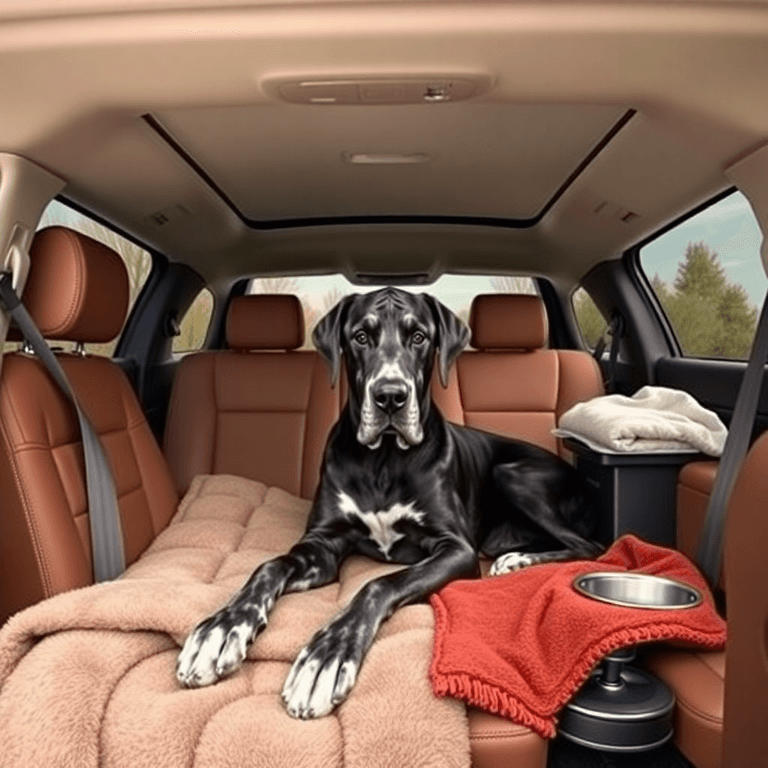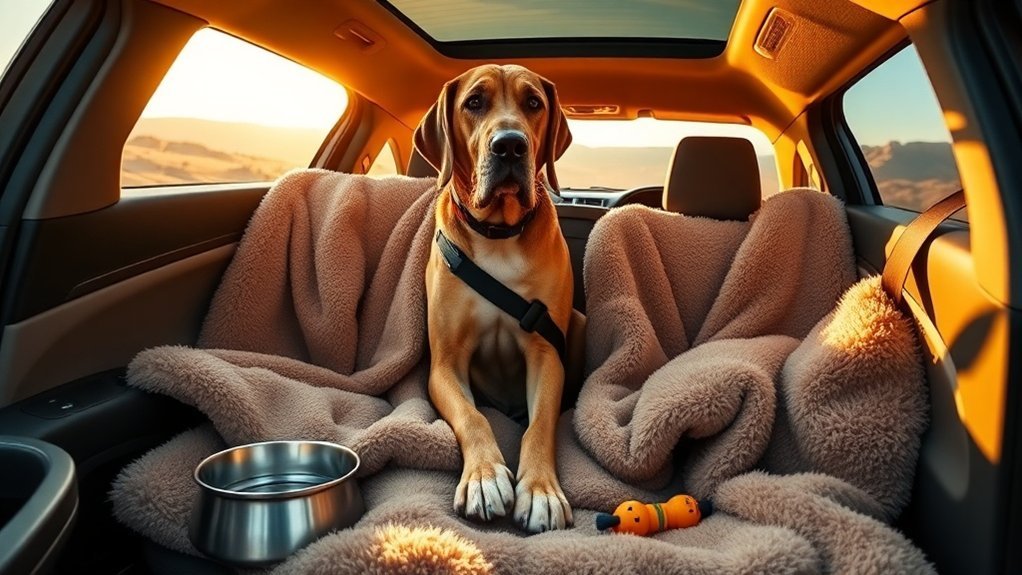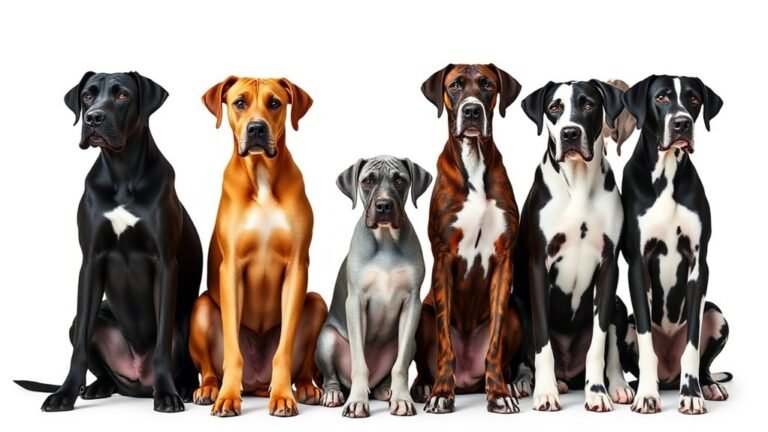Car Rides: The Only Time Humans Drive My Limo

Make Your Car Friendly for a Great Dane
Woof! Let me tell you what I need my humans to do to make car rides pawsome for a giant dog like me.
My humans better clear out that back seat, or I’ll be all squished up like a pretzel. Nobody wants a cranky Great Dane with leg cramps!
Safety first – even though I think I’m invincible, my humans insist on buckling me up. A good harness or travel crate keeps me from flying around if they hit the brakes too hard. Plus, it stops me from trying to help drive by putting my giant paws on the steering wheel.
Here’s the thing about my long legs – jumping into cars is not my strong suit. A ramp is like a red carpet entrance for us tall dogs. It saves my joints and keeps me from doing an embarrassing belly flop into the car.
Don’t forget about potty breaks! I can’t exactly use a tiny travel bathroom like humans. Every hour or two, I need to stretch these tree-trunk legs and find a good spot to do my business. A tired Great Dane is a good Great Dane, so some exercise stops keep me from getting restless.
Pack my favorite blankie or toy from home. New places can be scary, and familiar smells help me feel brave. Trust me, a nervous Great Dane takes up even MORE space somehow.
Follow these tips and we’ll have the best road trips ever!
Vehicle Space and Comfort Considerations
When my humans think about making the car comfortable for me, they need to remember that I’m basically a small horse who thinks he’s a lap dog. I need tons of space to stretch out my ridiculously long legs and maybe take a nap during our adventures.
My humans can make some cool changes to help me out. They could throw out all that junk they keep in the car (seriously, why do they need three umbrellas?) or maybe get a bigger vehicle. I’m not asking for a limo, but a minivan would be pretty sweet.
My humans could really step up their game by decluttering the car and maybe even getting a minivan for more space!
What I really need is a flat, grippy surface so I don’t slide around like I’m on an ice rink every time we turn a corner. Trust me, watching a Great Dane try to stay upright during a sharp left turn is both hilarious and terrifying.
My humans might want to check out those dog hammock things or special seat covers. I’ve heard good things about them from my buddy Rex down the street. Please, no tiny dog car seats – I’ve my dignity to think about.
When my humans put my needs first, every car ride becomes awesome instead of a wrestling match with physics. Plus, I promise to try not to drool on everything. No guarantees though – that’s just part of my charm. Speaking of which, having durable seat covers can really help protect the car from my occasional mishaps!
Safety Restraints and Equipment
When my humans take me for car rides, they always make sure I’m safe and sound. Trust me, as a Great Dane, I need some serious safety gear because I’m basically the size of a small horse!
My favorite option is wearing a special harness made just for big dogs like me. It keeps me secure without squishing my massive frame. I can still look out the window to bark at squirrels, but I won’t go flying if my human hits the brakes suddenly. That would be embarrassing for a dignified dog like myself.
Sometimes my humans put me in a travel crate, which is like my own personal bedroom on wheels. It’s pretty sweet, actually – I get my own cozy space where I can stretch out my long legs.
The crate has to be huge, though, because I need room to stand up without bumping my head on the ceiling. That’s happened before, and let me tell you, it’s not fun being a giant dog in a tiny space.
The best part about all this safety stuff? It means more car rides for me! My humans don’t worry about me bouncing around like a furry wrecking ball, so they’re happy to take me places. Additionally, using a front-clip harness ensures that I stay comfortable and secure during our adventures.
Win-win! Everyone stays safe, and I get to stick my head out the window and feel the wind in my ears.
Entry and Exit Accessibility
Getting In and Out of Cars is Ruff!
It’s not exactly what you’d call graceful! My humans quickly realized that watching me try to jump into their sedan was like watching a giraffe attempt gymnastics.
So they got smart and installed this excellent ramp for me. Now, instead of doing some crazy leap that makes me look like a clumsy superhero, I can just walk up like the dignified giant I am. The ramp adjusts, too, which is perfect because my humans seem to switch cars more often than I switch favorite tennis balls.
They also did some fancy stuff to the seats to give me more room. Before, I was folded up like a pretzel back there – my head touching the roof, my paws hanging over the seat. Not precisely the royal treatment a dog of my stature deserves! It’s essential for my humans to remember that Great Danes require adequate space in any environment, especially in a car.
Now I can actually sit like the majestic beast I am instead of looking like I’m playing an uncomfortable game of Twister.
The best part? No more stress about car rides! I used to get nervous just seeing the car keys because I knew an awkward wrestling match with the car door was coming.
Now, when I hear “road trip,” my tail starts wagging so hard it’s basically a helicopter propeller. My humans are happy, I’m delighted, and everyone wins!
Regular Exercise and Breaks During Travel
When we start our big adventures, I need to tell you something essential about us, Great Danes – we’re basically gentle giants who need our exercise breaks!
My humans have learned that I get pretty antsy if we don’t stop every couple of hours. I start doing this thing where I dramatically sigh and give them my best “Are we there yet?” look. Works every time!
My humans know I get restless without breaks, so I give them my best “Are we there yet?” look!
They’ve figured out that planning regular stops keeps me from turning into a 150-pound fidget spinner in the backseat.
The best part of road trips? Finding those awesome pet-friendly parks where I can stretch my long legs and show off my graceful galloping skills.
Okay, maybe “graceful” is generous – I’m more like a friendly tornado with floppy ears. But hey, I burn off all that pent-up energy, and everyone’s happy!
My favorite travel routine includes sniffing around new places, getting some water (I drink like a camel), and taking care of business. Pro tip from this Great Dane: those rest stops aren’t just for humans!
When my family remembers to give me these breaks, our trips are amazing. I’m calmer, they’re less stressed about my restlessness, and we all have more fun together. Plus, I get to meet new people who always say, “Wow, that’s a big dog!” Yes, yes, I am, and I’m proud of it! Regular exercise during travel is essential to maintaining a healthy weight and ensuring I stay fit and happy on our adventures.
Stress Management and Familiarity
Woof! Let me tell you about staying chill when we’re cruising in the car together. As a Great Dane, I’ve got some pretty big feelings about travel, and trust me, stress hits us four-legged folks just as hard as it hits you humans.
Picture this: I’m peacefully napping when suddenly – HONK! – Some crazy driver blasts their horn. My ears shoot up like satellite dishes, and my heart starts racing faster than a squirrel I’m chasing. Yeah, loud noises are not my thing when we’re on the road.
Here’s my secret weapon, though – I always pack my favorite squeaky hamburger toy. Don’t laugh! That little rubber burger has gotten me through more road trips than I can count on my oversized paws. When everything feels weird and scary, I give it a good squeeze and remember I’m safe with my favorite humans.
My people are pretty smart, too. They play this super relaxing music that drowns out all the honking and engine noise. Sometimes I even catch myself dozing off to it, which is saying something since I usually need to supervise everything happening outside the windows.
The best part of any trip? Pit stops! Every couple of hours, we pull over and I get to stretch these long legs of mine. I can sniff around, do my business, and remind myself that the world isn’t actually ending – we’re just moving our party to a new location. Plus, they always ensure I get enough regular exercise during our stops to help keep my anxiety in check.
Trust me, with the right game plan, road trips can be pawsome for everyone!
Final Thoughts
To wrap things up, making the car friendly for us Great Danes turns car rides from “Oh no, not again!” into “Are we there yet? Can we go somewhere else after this?” With plenty of room to stretch our super-long legs, the proper safety gear so we don’t become flying furballs, and lots of potty breaks (because let’s be honest, we drink A LOT of water), you humans make sure we feel awesome and safe. Don’t forget our favorite blankie and squeaky toy—just like how superheroes need their capes, we giant goofballs need our comfort stuff to feel brave on the road. When you do all this right, we get to go on amazing adventures together, complete with our tails whacking everything in sight and our happy “WOOF!” that probably makes your ears ring!




One Comment